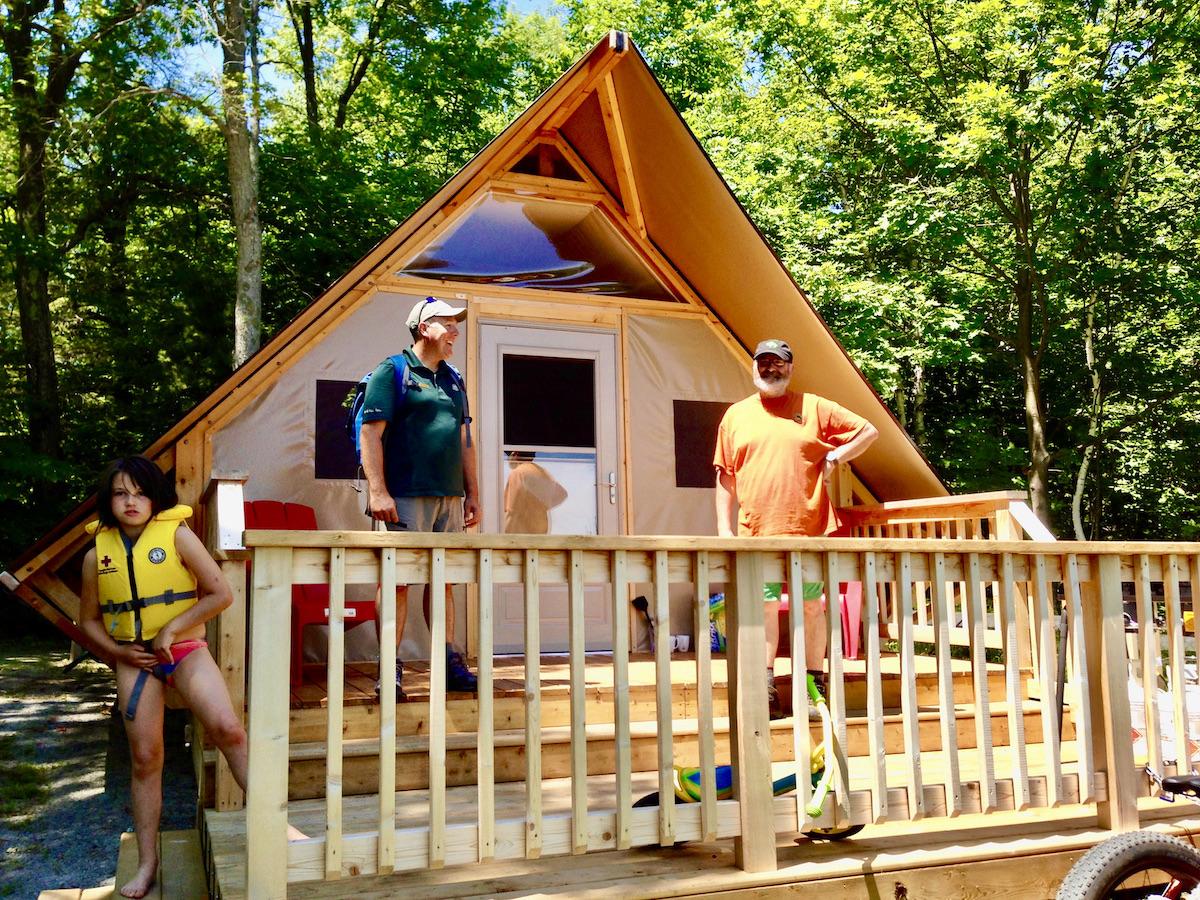
Author Jennifer Bain's family settles into an oTENTik at Georgian Bay Islands National Park with help from a Parks Canada employee/Parks Canada
Little did I know when my family slept in an oTENTik in Georgian Bay Islands National Park in 2016, and when I did a solo night in a MicrOcube in Riding Mountain National Park in 2017, that we were part of a quiet camping revolution.
Parks Canada was experimenting with roofed accommodations to reverse a worrying decline in overnight stays and test-driving creative options that would soon become staple products across the country.
Jump ahead to 2021 and Canada’s network of parks and national historic sites boast more than 400 oTENTIks, a handful of MicrOcubes and 34 teardrop-shaped Ôasis pods — all deliberately given unusual names to provoke buzz and instantly brand them to Parks Canada.
“We see these as an alternative form of camping,” says François Duclos, manager of visitor experience infrastructure. “Some people call it glamping, but this is a term we haven’t really latched on to because we’re not in the luxury business, we’re in the comfort business.”
Duclos is based in Quebec with a team of about 12 people in charge of “everything built,” like campgrounds, accommodations, trails, outhouses, washrooms and electric vehicle charging stations. He calls his department “very much a R&D (research and development) shop for tourism infrastructure.” They identify things that visitors need, brainstorm and then work with parks and historic sites to implement the solutions.
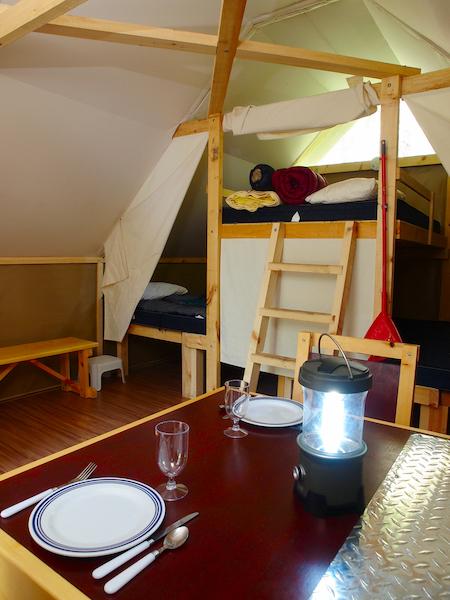
Inside an oTENTik, it's cozy but still feels like camping/Parks Canada
The national comfort camping project began around 2007 and 2008 when Parks Canada noticed that parks across the country were seeing troubling fluctuations and declines in camping. Older visitors were struggling with camping and others were new to the parks and didn’t know how to camp. “We started to wonder, what was the future of camping?” remembers Duclos. “And how can it improve or evolve in a way that keeps it relevant? We were a little bit scared.”
Local parks had already been experimenting for a year or two. Manitoba’s Riding Mountain, for example, already had a yurt. It’s considered a good place to test new products and “see if we’re on the right track” because it attracts a high number of loyal, repeat visitors, compared to something like Jasper National Park in Alberta, which may get more visitors overall but most come from abroad and come once.
In 2010, Parks Canada was ready to experiment with oTENTiks in Jasper’s alpine environment, Riding Mountain’s boreal forest and La Mauricie National Park in Quebec.
Halfway between a tent and an A-frame cabin, oTENTiks have raised floors, built-in beds and a table and chairs. They sleep five or six, have lighting and may also have heating, decks, some cooking equipment, a barbecue or a fire pit. Campers bring their own bedding, food, drink and flashlights. They don’t have washrooms or indoor kitchens.
“We launched in three places and it didn’t take long before it snowballed,” remembers Duclos. “Within just a couple of years, it became the staple item that we wanted it to be.” More than 400 oTENTiks are now located in 30 parks and historic sites in 11 out of 13 provinces and territories.
They’re usually grouped in clusters of 10 to create a sense of community, and they work in all environments — alpine, prairie, boreal forest, coastline and waterway. They start at $92 ($72 USD) a night, a price that varies depending on the time of the year and level of service. They usually include parking, but the one I stayed in at Georgian Bay Islands was — as the name suggests — on an island and so the parking was back at the shuttle boat launch.
The name oTENTik has a fun back story.
Duclos’s team wanted something unique, that would command attention, that wasn’t already in use and that would work in both of Canada’s official languages. The Quebec creators were calling the tent/cabin Prêt-À-Camper (Ready-To-Camp) but that was too pragmatic so they decided to play on the French word “authentique.” The “h” is silent when pronounced in French, making it sound like “o-tent-eek.” A few capital letters later, oTENTik was born.
In peak season (July and August), the average occupancy rate for oTENTiks is 92 per cent, people stay an average of 1.8 nights and the average party size is 3.6. There were 35,971 “occupied nights” in 2019.
This spring, Grand-Pré National Historic Site in Nova Scotia will unveil eight oTENTiks in the field south of the visitor information centre.
With oTENTiks a success, Duclos remembers sleeping in them while on the road for work and thinking about how he was alone and how his family wasn’t with him. “What about pair and couples?” his team wondered.
It experimented with double tents that had separate living and sleeping spaces, tiny homes and a sphere that hangs from trees, but those three options didn’t really work. Two other options — MicrOcubes and Ôasis pods — did.
The MicrOcube was ready to test in 2017. It’s a one-bedroom contemporary building with a timber frame dropped into nature. Inside is just 10 square metres (about 107 square feet) with a double bed, table, two chairs, lighting and a panorama window.
“We tried two MicrOcubes that year,” says Duclos. “You would have stayed in the very first one.” Indeed, my Riding Mountain MicrOcube was tucked into the forest between regular campsites and had a deck with bistro table and chairs, barbecue, picnic table and parking.
As with oTENTiks, you bring your own bedding and cooking equipment. Washrooms and showers are nearby. Prices start at $92.
Duclos laughs when I tell him the capital O in the middle of the name MicrOcube originally annoyed and confused me. (The first time I wrote about it, my editors changed it to Micro-Cube.)
“It’s like naming a child,” admits Duclos. “There’s tons of arguments and they may not all be rational. We wanted to be evocative. We wanted to include the name cube in the product name, and because we wanted to show that it’s small, cozy and intimate, the word micro came.” The capital “o” in the middle of the word helps Parks Canada “make its mark” on the ordinary word “microcube” and create “a bit of an image that people would slowly begin to recognize.”
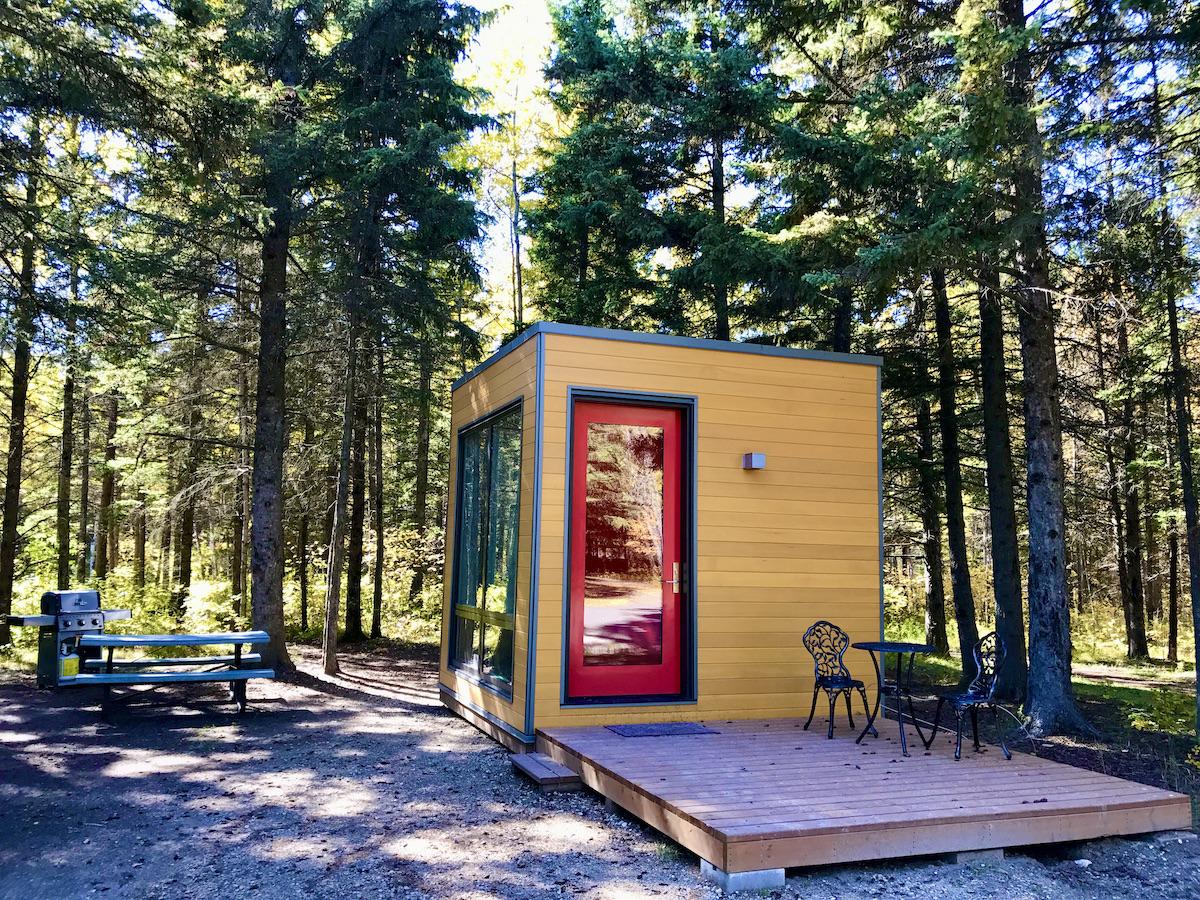
A MicrOcube in Riding Mountain National Park in 2017 when it was being tested/Jennifer Bain
MicrOcubes — now marketed as “a window for two with a nature view” — have been added to Quebec’s Forillon National Park, Mount Revelstoke National Park in British Columbia is getting three of them this year in its Snowforest Campground.
“The rollout is just starting,” concedes Duclos. “We have a little bit more effort to do on the MicrOcube to get the design right.”
That’s because Parks Canada’s most unique offering — Ôasis — also launched in 2017, this time at Fundy National Park in New Brunswick. It’s a teardrop-shaped “duplex” with a convertible table/bed on the main level and suspended hammock loft above. Inside it’s six square metres or about 64 square feet.
The product manufacturer called it Goutte d’Eau, which is French for waterdrop. Parks Canada was worried because people were mispronouncing the word goutte and associating it with gout, which is a form of inflammatory arthritis. They seized on “oasis” because it worked in both official languages, and they added an accent circonflexe to make it Ôasis.
“Obviously the word oasis would evoke water in the vast majority of people’s minds,” points out Duclos. But he also loves how the Ô “actually mimics the shape of the unit,” which is teardrop shaped and narrows to a pointed top.
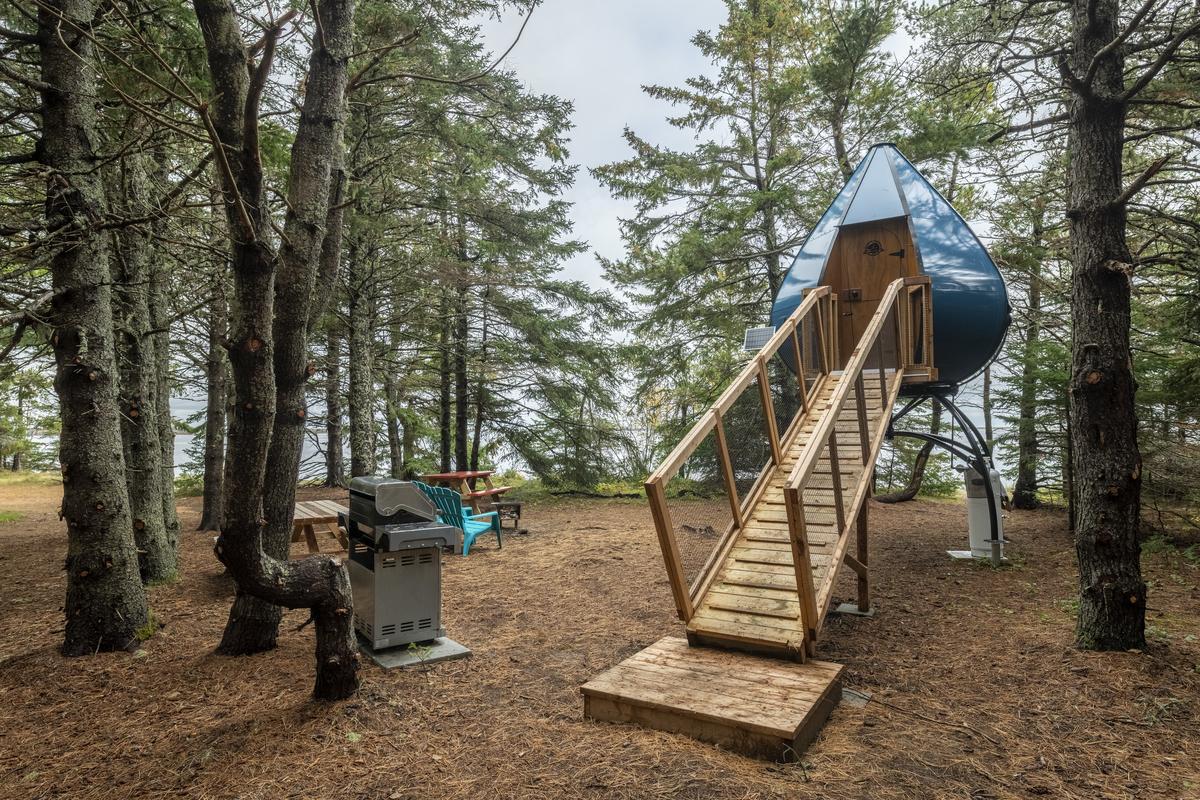
The teardrop-shaped Ôasis is an elevated accommodation offering/Parks Canada
I haven’t stayed in an Ôasis yet, but Duclos says “it’s on its own as an experience” and it’s not for everyone, namely those who’re not comfortable with its height. Placed in forest canopies and usually found in clusters of three to five, it’s marketed as “a drop of heaven for a night” and prices start at $122.5 (about $96 USD) a night. Some have heating and fire pits.
Eighteen new Ôasis units will be unveiled this year, bringing the national total to 34. Quebec’s Mingan Archipelago National Park Reserve will get three, while Quebec’s Forillon, Nova Scotia’s Kejimkujik National Park and National Historic Site, and Ontario’s Trent-Severn Waterway National Historic Site will each get five.
If you look Parks Canada’s camping and accommodations page, you’ll see the oTENTik, MicrOcube and Ôasis are mostly seasonal offerings, because most campgrounds aren’t winterized.
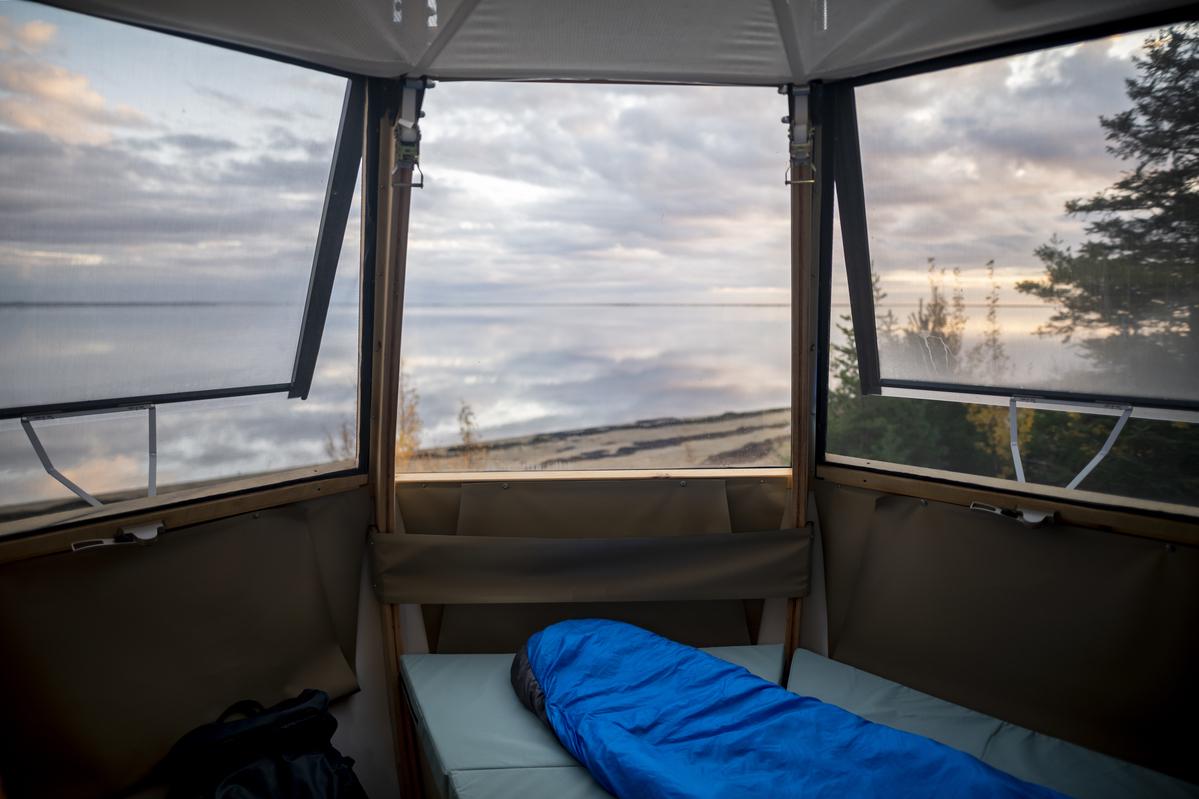
If you're okay with heights, the view from a teardrop-shaped Ôasis is spectacular/Parks Canada
There’s tent and RV camping, group camping, backcountry camping and equipped camping, of course, as well as overnight mooring where boaters can moor along historic canals — something I’ve done with a rented Le Boat houseboat along the Rideau Canal National Historic Site. You’ll see yurts in four locations, tipis in two and historic stays in nine. These are considered local — not national — offerings. Historic stays, in things like forts and lighthouses, are considered one-offs.
Finally, there are cabins in 10 spots across Canada. They sleep two to 12 people and most have their own washroom or outhouse. “These are self-contained and a much more inward experience than outward experience,” says Duclos. “These are probably the next big thing we’ll look at from a national perspective.”
Parks Canada isn’t mandated to generate a profit, so all of its camping and accommodations are priced for cost recovery so the agency doesn’t burden taxpayers. The fees always stay with the park.
Online and phone reservations would usually be open by now, but are delayed because of Covid-19 considerations and are slated open on staggered dates throughout April.

 Support Essential Coverage of Essential Places
Support Essential Coverage of Essential Places







Comments
All our campgrounds are full every year. It's becoming more and more frustrating. And when you do get there you're jammed right up tight to the people next door. We need a ton more campgrounds and give them space so it feels like camping. I rolled my eyes when the article said it places them closer together to create a sense of community. I go for peace and quiet not to feel a sense of community with people who spend the night getting hammered. I have neighbours at home for that.
Speak loudly to your government! Kenney has his eye on all Alberta public lands.